INTRODUCTION
A fitness disorder is any type of physical condition that significantly impacts one or more major life activities (Saebu, 2010). The World Health Organization has published public health guidelines and recommendations on physical activity and sedentary lifestyle for children, adolescents, and adults on the amount of physical activity that includes frequency, intensity, and duration as one of the preventive, promotive efforts to improve physical fitness and reduce health risks (WHO, 2016). In addition to physical activity, efforts to overcome fitness disorders can be made by utilizing traditional medicine (Imandiri et al., 2020).
The traditional healing system is a very common method and has been practiced in many countries since antiquity for treating physically and mentally ill people. Various things that encourage the use of traditional medicine include the lack of economic resources, relatively minimal side effects, accessibility of medical services, the high price of modern medicine, and the experience of failure in previous treatments (Junsongduang et al., 2020; Mahgoub, 2020).
The implementation of traditional medicine is highly dependent on the availability and richness of biodiversity in the region (Khanal et al., 2020). Papua is one of the islands in Indonesia that consist of two provinces, Papua and West Papua, with a large number of local ethnic groups with a large biodiversity, one of which is medicinal plants (Ananta et al., 2016). The existence of climate change and an increase in the earth’s temperature are predicted to have an impact on the survival of various medicinal plant species and their distribution areas, especially on the island of Papua and two other large islands, namely, Java and Sulawesi (Cahyaningsih et al., 2021). In addition, there is a tendency for the knowledge and abilities of traditional medicine that healers possess to be better documented, causing the potential to lose indigenous knowledge (Junsongduang et al., 2020).
Conducting and publishing ethnobiological research has become an important way of preserving and protecting knowledge about local medicine and other information for the next generations (Anyaoku et al., 2015; Pramanik, 2019; Simbiak et al., 2019). It is, however, crucial to conduct the study to document and inventory the wealth of local ethnomedicine knowledge, especially regarding the use of medicinal plants for the treatment of fitness disorders in Papua and West Papua ethnic groups in Indonesia.
MATERIALS AND METHODS
Study area
The study was conducted among 10 ethnic groups distributed in Papua and West Papua, as shown in Figure 1. Ethnic groups of Meyah, Inanwatam, Mey Brat, Waigeo, and Sough were located in Papua Province, while Yakai, Asmat, Ngalum, and Tobati ethnic groups administratively entered the province of West Papua. This study has obtained ethical approval from the Health Research Ethics Commission of the Health Research and Development Agency, Ministry of Health of the Republic of Indonesia.
Data collection
Data was collected in 2017 from 10 ethnic groups in Papua and West Papua. For each ethnic group, five traditional healers were selected that met various established inclusion criteria. They have both knowledge and treatment skills using medicinal plants; they are indigenous acculturated or people of the ethnic group and the most popular healer and recognized by the community. Direct interview based on a structured questionnaire among selected traditional healers was conducted in each ethnic group. Data on demography, sources of knowledge and healer’s skill, vernacular plant names, plant origin, plant part used, plant habitat, treated disease, symptoms of the disease, herbs used, the dosage used, preparation method, and the administration route were obtained by the questionnaire as the tool. After the interview with the healer was over, species specimens were observed and collected. The collected specimens were identified and preserved by the Herbarium Tawangmanguensis of the Medicinal Plant and Traditional Medicine Research and Development Center.
Data analysis
The data from this study were reported and stored in the Data Management Laboratory of the National Institutes of Health Research and Development. The data request follows the standard procedure of the Data Management Laboratory. Data were quantified by analyzing the use value (UV) parameters, simple preference ranking exercise, multi-health purpose species rank, and the plant parts value.
Use value
To measure the value of each medicinal plant species used by traditional healers to treat physical disorders in Papua and West Papua ethnic groups.
UVs = Σ UVis / ni
where UVs is the use value, UV is the citation number for each species, and ni is the total number of respondents interviewed (Ayyanar and Ignacimuthu, 2011).
 | Figure 1. The ethnic group location of the study processed with MapSource ®Garmin® mapping software: (1) Waigeo, (2) Mey Brat, (3) Inanwatam, (4) Meyah, (5) Sough, (6) Sumber Baba, (7) Asmat, (8) Yakai, (9) Tobati, and (10) Ngalum. [Click here to view] |
Plant part value (PPV)
To quantify the plant part (leaves, stem, root, fruit, stembark, and tubers) used percentage for physical disorders by traditional healers, the following equation was used.
PPV (%) = (ΣRU (plant part) / ΣRU) × 100
where PPV is described as the plant parts used to value and RU is the usage amount quoted for each plant part (Ayyanar and Ignacimuthu, 2011).
Species and multi-health purpose ranking exercise
Species ranking exercise was directed to grade the most picked medicinal plant for a specific illness symptom and disease. In this study, the rank exercise was based on citation numbers by informants (Alemneh, 2021). The bigger the citation number of the species, the better the rank. Other than for physical disorders, multi-health purposes were also determined to provide data on the use diversity of cited species for health purposes.
RESULTS
Demographic data of informants
This current study data demonstrated that from a total of 19 selected traditional healers having knowledge and skill in utilizing medicinal plants for curing illness, specifically for physical disorders in Papua and West Papua ethnic groups, the percentage of women with a main profession as traditional healers was greater than that of men, as shown in Table 1.
The selected traditional healers were dominated by generations with an age range of 40–60 years (78.95%), with the main livelihood as farmers (52.63%) and with low levels of education.
UV and medicinal plants utilized
The highest UV reported in this study was 0.21, and the lowest was 0.05. Each plant is equipped with various information, including the local name, plant family, plant part used, potion dose, disease symptoms, route of administration, and toxicity data obtained from previous studies (Table 2). As many as 24 species of medicinal plants were identified, complete with their toxicity profiles and identified secondary metabolites (Table 3), belonging to 19 plant families that traditional healers have used to treat physical disorders.
The most frequently used species for overcoming physical disorder by traditional healers in Papua and West Papua was lemongrass (Cymbopogon citratus), with the highest UV and use the percentage of 0.21% and 12.12%, as demonstrated in Table 2 and Figure 2. One of the specific medicinal plants inventoried in this study was red fruit (Pandanus conoideus Lam.), as shown in Table 2. The traditional healers utilized this species belonging to the Pandanaceae family to overcome physical disorders with specific symptoms. The body is quickly tired by boiling the ingredients with water and drinking it once a day after being filtered and chilled. This species is an indigenous Papuan plant and has been reported to contain various medicinal compounds, showed no toxicological effect among experimental rats, and has been widely used by local communities for multiple purposes, for health purposes, nutritional sources, and other reasons (Wismandanu et al., 2016). Figure 3 illustrates that Myrtaceae and Poaceae were recognized as the most utilized plant family by traditional healers from 19 plant families determined in this current study, followed by the families of Compositae, Annonaceae, and other families.
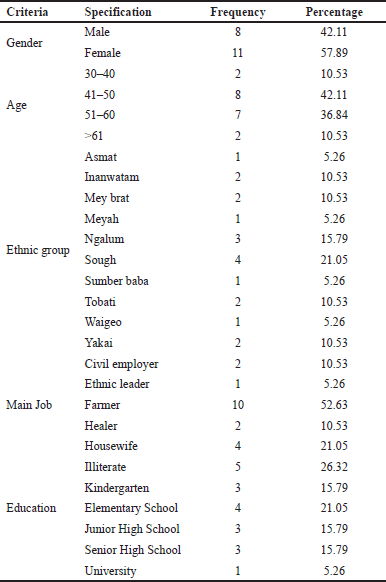 | Table 1. Demographic Information of the Selected Traditional Healers. [Click here to view] |
Plant part value
Leaves were indicated to be the most widely harvested and utilized plant parts by traditional healers in Papua and West Papua ethnic groups compared to other parts such as stem, root, fruit, stembark, and tubers, as shown by PPV for more than 75% as revealed in Figure 4. The study results showed that the level of concern for traditional healers for the survival of medicinal plant species was quite high, as indicated by the cultivation efforts that have been carried out by more than 60% of healers (Fig. 5).
Species and multi-health purpose ranking exercise
Morinda citrifolia was recognized as the first rank species with the biggest number of other treatable diseases with a total score of 85, followed by Psidium guajava, Annona muricata, Citrus aurantifolia, and other species with a score of 76, 46, and 17, respectively (Table 4). While C. citratus was identified as the first rank species reported to overcome physical disorders based on citation number by informants in Papua and West Papua by multi-health ranking exercise with a total score of 4 (Table 5).
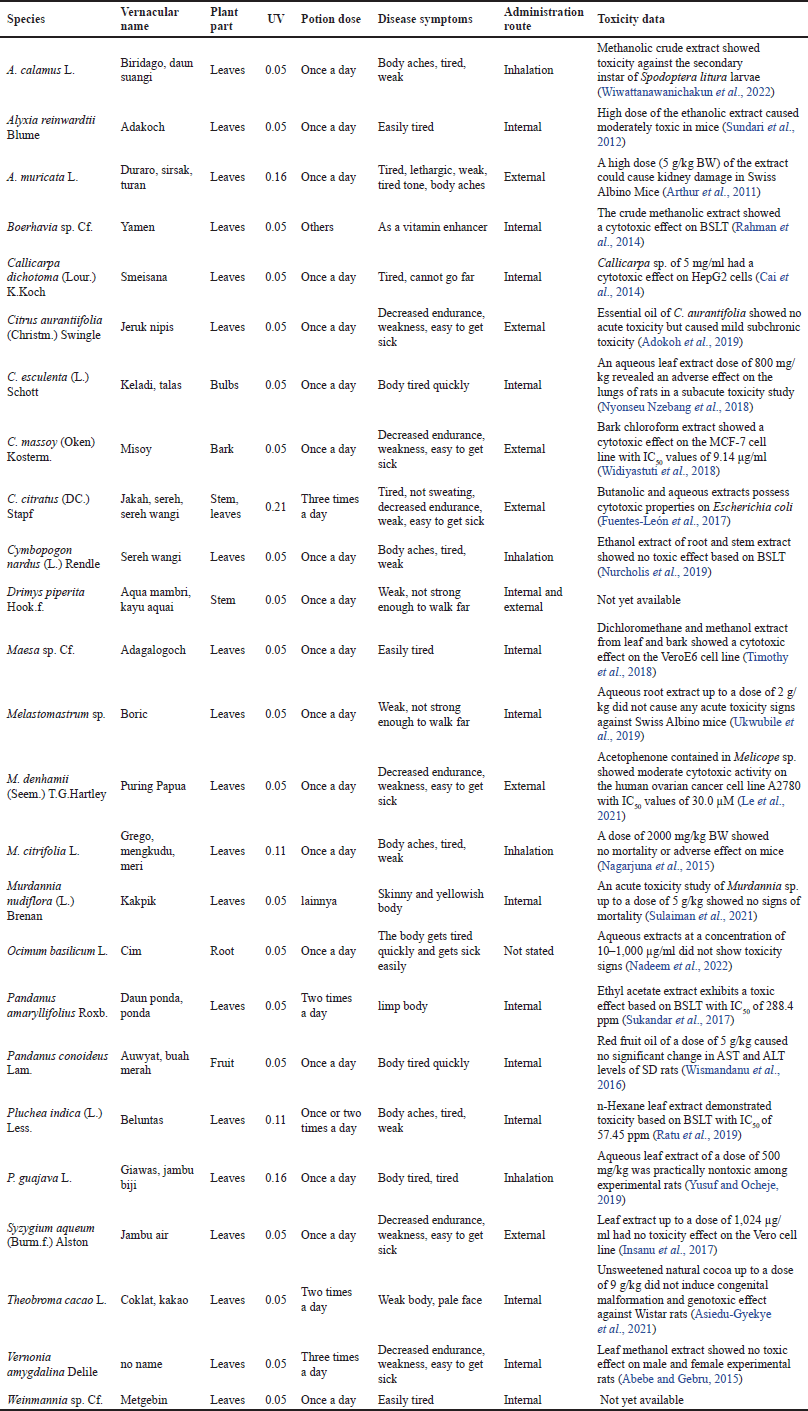 | Table 2. Medicinal plants utilized for treating physical disorders in Papua and West Papua, Indonesia. [Click here to view] |
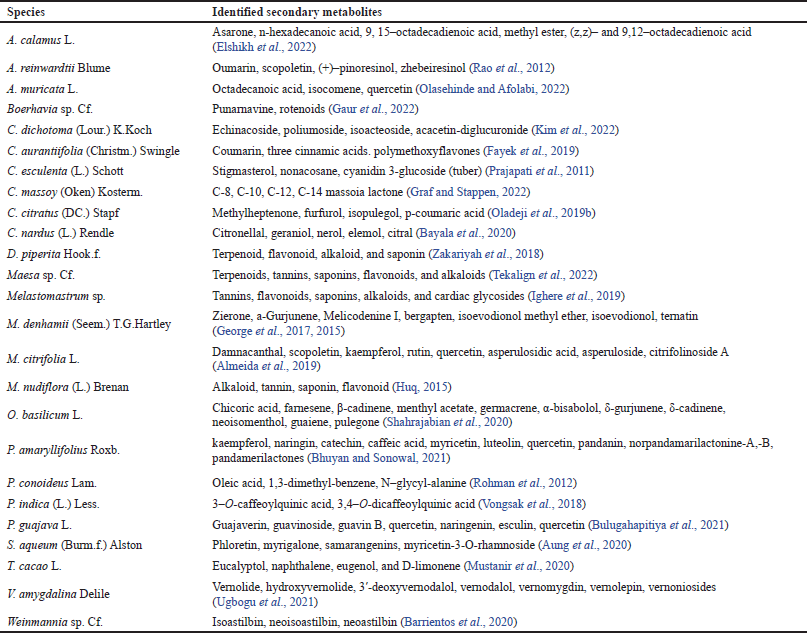 | Table 3. Identified secondary metabolites of recorded medicinal plant species. [Click here to view] |
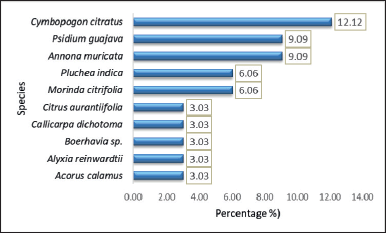 | Figure 2. The most prominent species utilized. [Click here to view] |
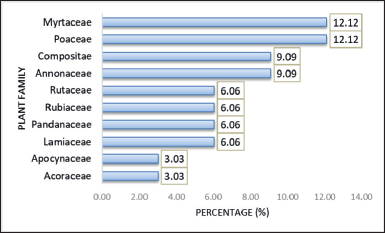 | Figure 3. The most cited plant families identified. [Click here to view] |
DISCUSSION
The crucial role of indigenous traditional healers and medicinal plants in dealing with health problems in society, especially in Papua and West Papua, Indonesia, is evident from the results of this study. The percentage of women who primarily work as traditional healers is greater than men in this study is in line with a previous study that stated that for women, the healing profession has a positive impact on improving their status and the status of women in society (Cabré, 2008; Popper-Giveon and Al-Krenawi, 2010). The role of women in medicine and healing has been proven throughout history, from the ancient world to the present, although in different forms (Jefferson et al., 2015). Another study stated that many men lost their prestige when they became traditional healers, while many women benefited in this regard (Bakker, 1992). However, this is not the case in Thailand, where traditional Thai medicine and healers are very important in Thai society, so men always crave these positions (Junsongduang et al., 2020). Conditions in which most of the traditional healers are more than 40 years old are also reported by Shuaib et al. (2021), whereas 51% of healers were between the ages of 30 and 50 years, with an illiterate level of 36% in Tahsil, Pakistan. Most people with the knowledge and skills to perform traditional medicine are elderly (Cheikhyoussef et al., 2011). It is stated that the people get older, their knowledge of medicinal plants expands (Srithi et al., 2009).
UV is a parameter that quantitatively indicates the relative importance of a plant species to a population (Sharif et al., 2022). Cymbopogon citratus has the highest UV. Cymbopogon citratus is also recorded as the first rank species reported to treat physical disorders based on citation number by simple ranking exercise with a total score of 4. Plant species with higher UV and use total score indicate that the species is likely to grow in abundance in the area, found mostly by local communities, and known to benefit local people for health purposes (Shuaib et al., 2021). Many previous studies have reported the phytoconstituents, such as citral, nerol, geraniol, citronellal, terpinolene, geranyl acetate, and terpinol, and pharmacological activities of C. citratus, including the analgesic, diuretic, carminative, galactagogue, antidepressant, antimicrobial, antipyretic, antiseptic, astringent, bactericidal, sedative and tonic effects (Majewska et al., 2019; Narayan and Maheshwari, 2017; Oladeji et al., 2019a; Olorunnisola et al., 2014; Shah et al., 2011). As a tonic and to treat a physical disorder, C. citratus works to improve health by enhancing the work of the respiratory, digestive, nervous, and excretory systems and facilitating the absorption of nutrients into the body, thereby providing strength and boosting the immune system (Narayan and Maheshwari, 2017).
Apart from treating physical disorders, recorded species were also used to treat other diseases. Morinda citrifolia was identified as the species with the biggest number of other treatable diseases, with a total score of 85. It showed that the utilization rate of this species for health purposes was the highest compared to other species and allowed the overharvesting of materials from nature, which can trigger its extinction. Based on The International Union for Conservation of Nature’s Red List of Threatened Species, no endangerment status of M. citrifolia is found, but out of a total of 24 documented species in this current study, there are five species with a status of Least Concern (LC), namely, A. muricata L., P. guajava L., Acorus calamus L., Colocasia esculenta (L.) Schott, and Melicope denhamii (Seem.) T.G. Hartley; a species (Cryptocarya massoy (Oken) Kosterm.) with Extinct (E) status; a species, Weinmannia sp. Cf, with near threatened status. The only threat reported to C. massoy is the continuous harvesting of its bark for its high demand in the perfumery market due to its sweet fragrance. This is in accordance with the conditions in Papua and West Papua ethnic groups, whereas from this current study results, it is known that the species part used for health purposes is also the bark; moreover, 40% of the informants still conducted no cultivation effort (Fig. 5).
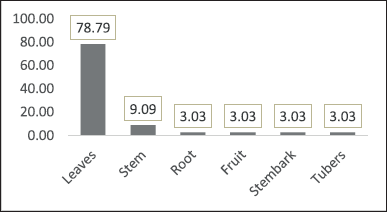 | Figure 4. Plant parts used by traditional healers. [Click here to view] |
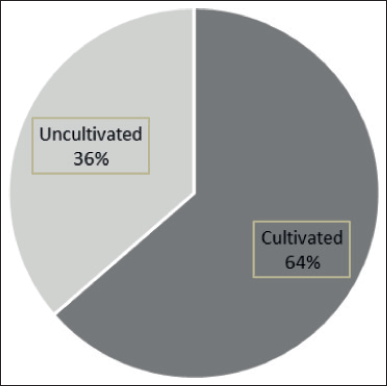 | Figure 5. Cultivation status of utilized medicinal plants. [Click here to view] |
Myrtaceae and Poaceae were recognized as the most utilized plant families by traditional healers from a total of 19 plant families determined in this current study. Poaceae was reported to have the largest number of species in the Rongkong ethnic group (Mustofa et al., 2020). Ahmad et al. (2022) reported that the Myrtaceae family, which consists of 140 genera and about 3,500–5,800 species, is the most well-known essential oil-producing plant in the community and is widely used for medical and commercial purposes (Ahmad et al., 2022). Moreover, about 1,800 plant species belonging to the genus Syzygium in this family have been widely used in traditional medicine systems in Asian countries, including Indonesia (Uddin et al., 2022). Meanwhile, the Poaceae family, which comprises 119 genera and 1,482 described species, is also reported to have been used by indigenous people and native communities in Asian countries, specifically to treat certain diseases and ailments.
Compared to other plant parts, leaves are the most harvested and utilized parts by traditional healers in Papua and West Papua. This is in accordance with several previous studies that reported leaves as the most frequently used part (Mustofa et al., 2020; Nisa et al., 2022; Radha et al., 2021; Rahmawati et al., 2020; Sharif et al., 2022; Subba et al., 2022). Compared to other plant parts, leaves are generally available in more significant quantities in a plant, so leaf harvesting is considered safer and does not have a negative impact on plant survival (Rabgyal and Pelden, 2021). Furthermore, the leaves also contain various bioactive components, such as flavonoids, alkaloids, phenols, and saponins, which are predicted to be responsible for their pharmacological activities (Friday et al., 2011).
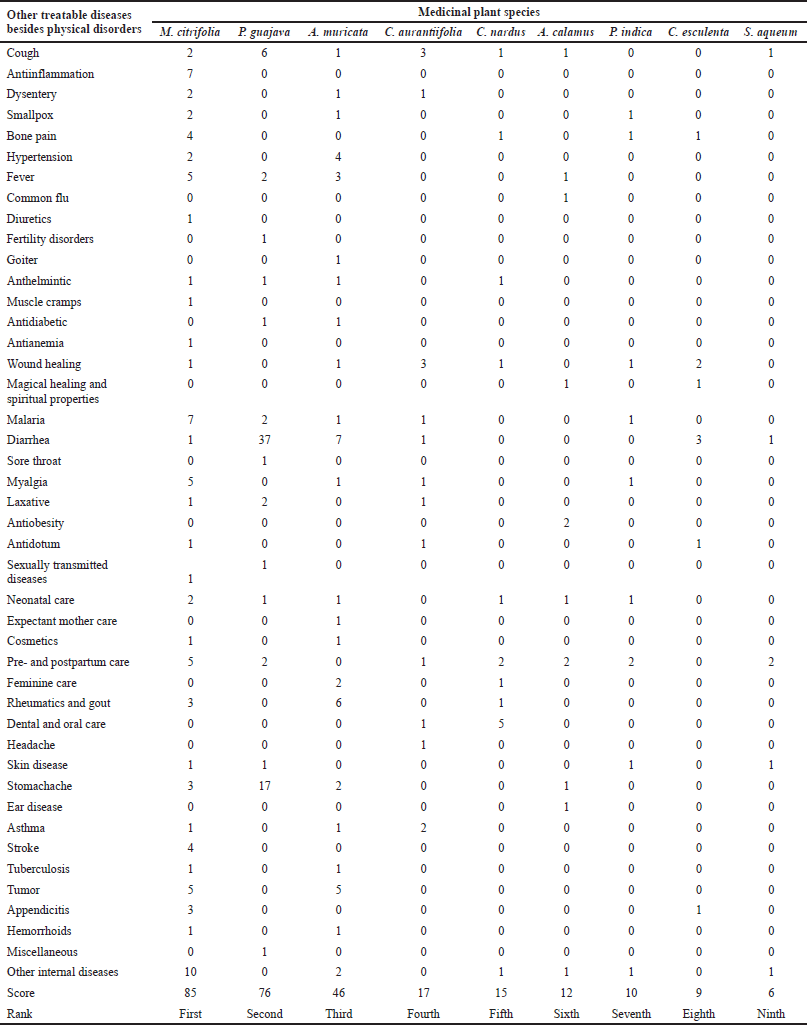 | Table 4. Ranking of 9 plant species by 19 informants based on other treatable diseases’ numbers. [Click here to view] |
 | Table 5. Ranking of 9 plant species by 19 informants based on other treatable diseases’ numbers. [Click here to view] |
The concern levels of traditional healers about the survival of medicinal plant species are quite high, as indicated by the cultivation efforts that have been carried out by more than 60% of healers. This is in accordance with a previous study reported by Ungirwalu et al. (2017) that examined whether local knowledge regarding sustainable use and the traditional concept of forest resources conservation have been established in Papua, but this traditional wisdom is less exposed in the scientific literature (Ungirwalu et al., 2017). However, the initiation of cultivation needs to be carried out considering that almost 40% of healers still treat their patients using medicinal plants by collecting and harvesting existing plants without cultivating them. Moreover, local communities in Papua tend to use the forest for their daily needs (Sundari et al., 2020). Thus, a close synergy between local communities and their environment is expected to contribute positively to sustainable biodiversity resource management (Ungirwalu et al., 2017).
CONCLUSION
This study demonstrated that the study area has plenty of medicinal plants to treat ailments specifically for physical disorders. As many as 43 concoction information details and 24 plant species distributed in 19 families among 19 healers in 10 ethnic groups in Papua and West Papua were documented. Cymbopogon citratus (DC.) Stapf (12.12%) and leaves (57.35%) were determined as the most prominent species and plant parts used. Morinda citrifolia was identified as the species with the biggest number of other treatable diseases, with a total score of 85. The most used plant families were Myrtaceae and Poaceae, each with a percentage of 12.12%. This showed the important role of both medicinal plants and traditional healers in community health. Since almost 40% of traditional healers still harvested the available plants and practiced no cultivation, conservation efforts need to be started immediately to prevent the extinction of these medicinal plants.
ACKNOWLEDGMENT
The authors thank all traditional healers in Papua and West Papua and the Ristoja 2017 team and B2P2TOOT for conducting Ristoja.
AUTHOR CONTRIBUTIONS
NR, DS, SH, IYMS, DSu, HW, RM, and YW were responsible for the conceptualization, preparation of the original draft, and review and editing of the manuscript; NR and RM contributed to the methodology and data curation; RM and IYMS were responsible for the software; HW, NR, and DS validated the data; NR, DSu, and IYMS conducted the formal analysis; SH conducted the investigation; NR and DS were responsible for the resources; NR was responsible for the visualization; YW, HW, and SH supervised the study. All authors contributed to editorial changes in the manuscript. All authors read and approved the final manuscript.
FINANCIAL SUPPORT
This research was funded by the Medicinal Plant and Traditional Medicine Research and Development Center, NIHRD, MoH RI, with decree number HK.02.03/I/1825/2017.
CONFLICTS OF INTEREST
The authors declare no conflicts of interest.
ETHICAL APPROVALS
This study has obtained ethical approval with the number of LB.02.02/2/KE.107/2017 from the Health Research Ethics Commission of the Health Research and Development Agency, Ministry of Health of the Republic of Indonesia.
DATA AVAILABILITY
All data generated and analyzed are included in this research article.
PUBLISHER’S NOTE
This journal remains neutral with regard to jurisdictional claims in published institutional affiliation.
REFERENCES
Abebe MS, Gebru G. Toxic effect of Vernonia amygdalina on blood parameters and histopathology of liver and kidney in Rats. Glob Acad Res J, 2015; 1:1–8.
Adokoh CK, Asante DB, Acheampong DO, Kotsuchibashi Y, Armah FA, Sirikyi IH, Kimura K, Gmakame E, Abdul-Rauf S. Chemical profile and in vivo toxicity evaluation of unripe Citrus aurantifolia essential oil. Toxicol Rep, 2019; 6:692–702; doi:10.1016/j.toxrep.2019.06.020 CrossRef
Ahmad I, Arifianti AE, Nur Fikri JA, Abdullah S, Munim A. The combination of ATR-FTIR and chemometrics for rapid analysis of essential oil from Myrtaceae plants—a review. J Appl Pharm Sci, 2022; 12:30–42; doi:10.7324/japs.2022.120604 CrossRef
Alemneh D. Ethnobotanical study of medicinal plants used for the treatment of domestic animal diseases in Yilmana Densa and Quarit districts, West Gojjam zone, Amhara region, Ethiopia. Ethnobotany Res Appl, 2021:1–8; doi:10.32859/ERA.22.28.1-16 CrossRef
Almeida ÉS, de Oliveira D, Hotza D. Properties and applications of Morinda citrifolia (Noni): a review. Compr Rev Food Sci Food Saf, 2019; 00:1–27; doi:10.1111/1541-4337.12456 CrossRef
Ananta A, Utami DRWW, Handayani NB. Statistics on ethnic diversity in the land of Papua, Indonesia. Asia Pac Policy Stud, 2016; 3:458–74; doi:10.1002/app5.143 CrossRef
Anyaoku EN, Nwafor-Orizu OE, Eneh EA. Collection and preservation of traditional medical knowledge: roles for medical libraries in Nigeria. J Lib Inform Sci, 2015; 3; doi:10.15640/jlis.v3n1a2 CrossRef
Arthur F, Woode E, Terlabi E, C L. Evaluation of acute and subchronic toxicity of Annona muricata (Linn.) aqueous extract in animals. Eur J Experiment Biol, 2011; 1:115–24.
Asiedu-Gyekye IJ, Borovskaya TG, Poluektova ME, Vychuzhanina A V., Shchemerov? YA, Kamalova SI, Grgoreva VA, Amoateng P, Kukuia KE, Kwapong AA, Allotey Babington L, Amponsah SK, N’guessan BB. Reproductive toxicity of Theobroma cacao: increase in survival index, nongenotoxic, and proimplantation potential. J Toxicol, 2021; 2021:1–3; doi:10.1155/2021/6114672 CrossRef
Aung EE, Kristanti AN, Aminah NS, Takaya Y, Ramadhan R. Plant description, phytochemical constituents and bioactivities of Syzygium genus: a review. Open Chem, 2020; 18:1256–81; doi:10.1515/chem-2020-0175 CrossRef
Ayyanar M, Ignacimuthu S. Ethnobotanical survey of medicinal plants commonly used by Kani tribals in Tirunelveli hills of Western Ghats, India. J Ethnopharmacol, 2011; 134:851–64; doi:10.1016/j.jep.2011.01.029 CrossRef
Bakker J. The rise of female healers in the middle Atlas, Morocco. Soc Sci Med, 1992; 35:819–29; doi:10.1016/0277-9536(92)90082-2 CrossRef
Barrientos R, Fernández-Galleguillos C, Pastene E, Simirgiotis M, Romero-Parra J, Ahmed S, Echeverría J. Metabolomic analysis, fast isolation of phenolic compounds, and evaluation of biological activities of the bark from Weinmannia trichosperma Cav. (Cunoniaceae). Front Pharmacol, 2020; 11; doi:10.3389/fphar.2020.00780 CrossRef
Bayala B, Coulibaly AY, Djigma FW, Nagalo BM, Baron S, Figueredo G, Lobaccaro JA, Simpore J. Chemical composition, antioxidant, anti-inflammatory and antiproliferative activities of the essential oil of Cymbopogon nardus, a plant used in traditional medicine. Biomol Concepts, 2020; 11:86–96; doi:10.1515/bmc-2020-0007 CrossRef
Bhuyan B, Sonowal R. An overview of Pandanus amaryllifolius Roxb.ex Lindl. and its potential impact on health. Curr Trends Pharm Res, 2021; 8:138–57.
Bulugahapitiya VP, Kokilananthan S, Manawadu H, Gangabadage CS. Phytochemistry and medicinal properties of Psidium guajava L. leaves: a review. Plant Sci Today, 2021; 8:963–71; doi:10.14719/pst.2021.8.4.1334 CrossRef
Cabré M. Women or healers? Household practices and die categories of health care in late medieval Iberia. Bull Hist Med, 2008; 82:18–51; doi:10.1353/bhm.2008.0040 CrossRef
Cahyaningsih R, Phillips J, Magos Brehm J, Gaisberger H, Maxted N. Climate change impact on medicinal plants in Indonesia. Glob Ecol Conserv, 2021; 30:e01752; doi:10.1016/j.gecco.2021.e01752 CrossRef
Cai H, Xie Z, Liu G, Sun X, Peng G, Lin B, Liao Q. Isolation, identification and activities of natural antioxidants from Callicarpa kwangtungensis Chun. PLos One, 2014; 9; doi:10.1371/journal.pone.0093000 CrossRef
Cheikhyoussef A, Shapi M, Matengu K, Mu Ashekele H. Ethnobotanical study of indigenous knowledge on medicinal plant use by traditional healers in Oshikoto region, Namibia. J Ethnobiol Ethnomed, 2011; 7:10; doi:10.1186/1746-4269-7-10 CrossRef
Elshikh MS, Rani E, al Farraj DA, Al-Hemaid FMA, Abdel Gawwad MR, Jeba Malar TRJ, Dyona L, Vijayaraghavan P. Plant secondary metabolites extracted from Acorus calamus rhizome from Western Ghats, India and repellent activity on Sitophilus oryzae. Physiol Mol Plant Pathol, 2022; 117; doi:10.1016/j.pmpp.2021.101743 CrossRef
Fayek NM, Farag MA, Abdel Monem AR, Moussa MY, Abd-Elwahab SM, El-Tanbouly ND. Comparative metabolite profiling of four citrus peel cultivars via ultra-performance liquid chromatography coupled with quadrupole-time-of-flight-mass spectrometry and multivariate data analyses. J Chromatogr Sci, 2019; 57:349–60; doi:10.1093/chromsci/bmz006 CrossRef
Friday ET, James O, Olusegun O, Gabriel A. Investigations on the nutritional and medicinal potentials of Ceiba pentandra leaf: a common vegetable in Nigeria. Int J Plant Physiol Biochem, 2011; 3:95–101.
Fuentes-León F, González-Pumariega M, Tamayo MV, Menck CFM, Sánchez-Lamar Á. Toxic evaluation of Cymbopogon citratus chemical fractions in E. coli. Cosmetics, 2017; 4; doi:10.3390/cosmetics4020020 CrossRef
Gaur PK, Rastogi S, Lata K. Correlation between phytocompounds and pharmacological activities of Boerhavia diffusa Linn with traditional-ethnopharmacological insights. Phytomed Plus, 2022; 2; doi:10.1016/j.phyplu.2022.100260 CrossRef
George S, Nair SA, Venkataraman R, Baby S. Chemical composition, antibacterial and anticancer activities of volatile oil of Melicope denhamii leaves. Nat Prod Res, 2015; 29:1959–62; doi:10.1080/14786419.2015.1013471 CrossRef
George S, Venkataraman R, Baby S. Melicodenine I, A new quinolinone alkaloid from Melicope denhamii leaves. Nat Prod Res, 2017; 31:890–5; doi:10.1080/14786419.2016.1253075 CrossRef
Graf M, Stappen I. Beyond the bark: an overview of the chemistry and biological activities of selected bark essential oils. Molecules, 2022; 27; doi:10.3390/molecules27217295 CrossRef
Huq S. Comparative phytochemical evaluation and biological activity screening of Murdannia nudiflora and Tradescantia pallida. Brac University, Dhaka, Bangladesh, 2015, pp 1–118.
Ighere DA, Ezenwata CJ, Edagbo DE, Alowonle AA, Lawyer EF, Michael C, Abaku NS, Oham R, Dave-Omoregie AO, Okere OD. Phytochemical and antibacterial properties of methanolic extracts of Melastomastrum capitatum leaves. Asian J Biol Sci, 2019; 13:98–104; doi:10.3923/ajbs.2020.98.104 CrossRef
Imandiri A, Pratama DS, Rahman A. Increasing fitness with acupuncture and herbs. J Vocation Health Studies, 2020; 04:5–11; doi:10.20473/jvhs.V4I1.2020.5-11 CrossRef
Insanu M, Mutia C, Artarini AA. In vitro toxicity testing of extracts and fractions of water guava leaves (Syzygium aqueum) and pomegranate peel (Punica granatum) against vero cells. Acta Pharm Indones, 2017; 42:76–83.
Jefferson L, Bloor K, Maynard A. Women in medicine: historical perspectives and recent trends. Br Med Bull, 2015; 114:5–15; doi:10.1093/bmb/ldv007 CrossRef
Junsongduang A, Kasemwan W, Lumjoomjung S, Sabprachai W, Tanming W, Balslev H. Ethnomedicinal knowledge of traditional healers in Roi Et, Thailand. Plants, 2020; 9:1–15; doi:10.3390/plants9091177 CrossRef
Khanal DP, Raut B, Magar YT. Traditional healing practices using herbal dosage forms and other agents by Magar community of Gulmi district, Nepal. J Manmohan Mem Inst Health Sci, 2020; 6:20–38; doi:10.3126/jmmihs.v6i1.30533 CrossRef
Kim EN, Lee HS, Jeong GS. Callicarpa dichotoma leaf extract alleviates atopic dermatitis through the suppression of T cells and keratinocytes activation. Pharmaceuticals, 2022;15; doi:10.3390/ph15101280 CrossRef
Le K, Bandolik JJ, Kassack MU, Wood KR, Paetzold C, Appelhans MS, Passreiter CM. New Acetophenones and chromenes from the leaves of Melicope barbigera A. Gray. Mole, 2021; 26:1–4.
Mahgoub AT. The relation between education level and attending traditional healers in Khartoum locality. Case study in Khartoum State. Sudan. Am J Human Soc Sci Res, 2020; 4:112–9.
Majewska E, Kozlowska M, Gruczynska-Sekowska E, Kowalska D, Tarnowska K. Lemongrass (Cymbopogon citratus) essential oil: extraction, composition, bioactivity and uses for food preservation—a review. Pol J Food Nutr Sci, 2019; 69:327–41; doi:10.31883/pjfns/113152 CrossRef
Mustanir, Nurdin, Ginting B, Purnama A. Chemical composition and cytotoxic activities of n-Hexane extract from cacao pod husk (Theobroma cacao L.). Chem Data Collect, 2020; 30:100553; doi:10.1016/j.cdc.2020.100553 CrossRef
Mustofa FI, Rahmawati N, Aminullah. Medicinal plants and practices of Rongkong traditional healers in South Sulawesi, Indonesia. Biodiversitas, 2020; 21; doi:10.13057/biodiv/d210229 CrossRef
Nadeem HR, Akhtar S, Sestili P, Ismail T, Neugart S, Qamar M, Esatbeyoglu T. Toxicity, antioxidant activity, and phytochemicals of basil (Ocimum basilicum L.) leaves cultivated in Southern Punjab, Pakistan. Foods, 2022; 11:1–3; doi:10.3390/foods11091239 CrossRef
Nagarjuna R, Krishna GR, Rao VK, Balaji C, Prabhudeva M, Kumar AR, Rami Reddy AJ, Vallabh V. Toxicity studies of extract of Morinda citrifolia. Int J Pharm Chem Biol Sci, 2015; 5:141–5.
Narayan P, Maheshwari a RK. Astonishing Cymbopogon citratus (Lemongrass) for Healthcare Prakash. Res J Chem Environ Sci, 2017; 5:84–90.
Nisa U, Triyono A, Ardiyanto D, Novianto F, Fitriani U, Jannah WDM, Astana PR, Zulkarnain Z. Ethnopharmacological study of medicinal plants indigenous knowledge about low back pain therapy in Sumatra, Indonesia. J Appl Pharm Sci, 2022; 12:178–88; doi:10.7324/JAPS.2022.120921 CrossRef
Nurcholis W, Weni M, Fitria R, Najmah, Manek KR, Habibie BY. toxicity test of roots, stems and leaves of Lemongrass (Cymbopogon nardus). Current Biochem, 2019; 6:78–85; doi:10.29244/cb.6.2.6 CrossRef
Nyonseu Nzebang DC, Ngaha Njila MI, Bend EF, Oundoum Oundoum PC, Koloko BL, Bogning Zangueu C, Belle Ekedi P, Sameza M, Massoma Lembè D. Evaluation of the toxicity of Colocasia esculenta (Aracaceae): preliminary study of leaves infected by Phytophthora colocasiae on Wistar albinos rats. Biomed Pharmacother, 2018; 99:1009–3; doi:10.1016/j.biopha.2017.12.061 CrossRef
Oladeji OS, Adelowo FE, Ayodele DT, Odelade KA. Phytochemistry and pharmacological activities of Cymbopogon citratus: a review. Sci Afr, 2019a; 6:e00137; doi:10.1016/j.sciaf.2019.e00137 CrossRef
Oladeji OS, Adelowo FE, Ayodele DT, Odelade KA. Phytochemistry and pharmacological activities of Cymbopogon citratus: a review. Sci Afr, 2019b; 6:e00137; doi:10.1016/j.sciaf.2019.e00137 CrossRef
Olasehinde OR, Afolabi OB. Identification of bioactive constituents of chloroform fraction from Annona muricata leaf, its antioxidant activity and inhibitory potential against carbohydrate-hydrolyzing α-amylase and α-glucosidase activities linked to type II diabetes mellitus: in vitro study. J Herbmed Pharmacol, 2022; n12:100–8; doi:10.34172/jhp.2023.09 CrossRef
Olorunnisola SK, Asiyanbi HT, Hammed AM, Simsek S. Biological properties of lemongrass: an overview. Int Food Res J, 2014; 21:455–62.
Popper-Giveon A, Al-Krenawi A. Women as healers; women as clients: the encounter between traditional Arab women healers and their clients. Cult Med Psychiatry, 2010; 34:468–99; doi:10.1007/s11013-010-9184-9 CrossRef
Prajapati R, Kalariya M, Umbarkar R, Parmar S, Sheth N. Colocasia esculenta: a potent indigenous plant. Int J Nutr Pharmacol Neurol Dis 2011;1:90; doi:10.4103/2231-0738.84188 CrossRef
Pramanik R. Documentation and digitalization for access to traditional medicine knowledge in Southern Odisha 2019; doi:10.1007/978-981-13-8090-7 CrossRef
Rabgyal J, Pelden K. Sustainable harvesting practices for endangered medicinal plants of Bhutan. Agriculture Research and Development Centre, Yusipang, Thimphu, Bhutan, 2021.
Radha R, Chauhan P, Puri S, Thakur M, Rathour S, Sharma AK, Pundir A. A study of wild medicinal plants used in Nargu Wildlife Sanctuary of district Mandi in Himachal Pradesh, India. J Appl Pharm Sci, 2021; 11:135–44; doi:10.7324/JAPS.2021.110416 CrossRef
Rahman SM, Alam MM, Amin MR, Fakruddin M, Shahid-Ud-Daula A, Siddiqui R. Antimicrobial activity and brine shrimp toxicity of methanolic whole plant extract of Boerhavia repens L. (Family: Nyctaginaceae). Int J Phytopharm, 2014; 4:135–9; doi:10.7439/ijpp CrossRef
Rahmawati N, Mustofa FI, Haryanti S. Diversity of medicinal plants utilized by to manui ethnic of central Sulawesi, Indonesia. Biodiversitas, 2020; 21:375–92; doi:10.13057/biodiv/d210145 CrossRef
Rao N, Ravi G, Goud SK. Isolation and identification of anti oxidizing agents from Alyxia reinwardtii. J Pharm Sci Res, 2012; 4:1859.
Ratu AP, Nunang PPL, Suryaganda PJ. Uji toksisitas daun beluntas (Pluchea indica Less), daun kemangi (Ocimum basilicum L.) dan kulit daging buah jengkol (Archidendron pauciflorum) dengan metode Brine Shrimp Leyhality Test (BSLT). The 8th University Research Colloquium 2018, Universitas Muhammadiyah Purwokerto, Purwokerto, Indonesia, 2019, pp 60–5.
Rohman A, Sugeng R, Che Man YB. Characterizaton of red fruit (Pandanus conoideus Lam) oil. Int Food Res J, 2012; 19:563–7.
Saebu M. Physical disability and physical activity: a review of the literature on correlates and associations. Eur J Adap Phys Activity, 2010; 3:37–55; doi:10.5507/euj.2010.008 CrossRef
Shah G, Shri R, Panchal V, Sharma N, Singh B, Mann AS. Scientific basis for the therapeutic use of Cymbopogon citratus, Stapf (Lemon grass). J Adv Pharm Technol Res, 2011; 2:3–8; doi:10.4103/2231-4040.79796 CrossRef
Shahrajabian MH, Sun W, Cheng Q. Chemical components and pharmacological benefits of basil (Ocimum basilicum): a review. Int J Food Prop, 2020; 23:1961–70; doi:10.1080/10942912.2020.1828456 CrossRef
Sharif A, Shah NA, Rauf A, Hadayat N, Gul A, Nawaz G, Sakhi S, Iqbal M, Khan MR, Shah AA, Azam N, Iftikhar H, Shah SA, Bahadur S, Hussain F, Shuaib M. Ethnomedicinal uses of plants for various diseases in the remote areas of Changa Manga Forest, Pakistan. Brazilian J Biol, 2022; 84:1–33; doi:10.1590/1519-6984.255916 CrossRef
Shuaib M, Hussain F, Rauf A, Jan F, Romman M, Parvez R, Zeb A, Ali S, Abidullah S, Bahadur S, Shah AA, Azam N, Dilbar S, Begum K, Khan H, Sajjad S, Muhammad I, Shah NA. Traditional knowledge about medicinal plant in the remote areas of Wari Tehsil, Dir Upper, Pakistan. Brazil J Biol, 2021; 83:1–28; doi:10.1590/1519-6984.246803 CrossRef
Simbiak M, Supriatna J, Walujo EB, Nisyawati. Current status of ethnobiological studies in Merauke, Papua, Indonesia: a perspective of biological-cultural diversity conservation. Biodiversitas, 2019; 20:3455–66; doi:10.13057/biodiv/d201201 CrossRef
Srithi K, Balslev H, Wangpakapattanawong P, Srisanga P, Trisonthi C. Medicinal plant knowledge and its erosion among the Mien (Yao) in northern Thailand. J Ethnopharmacol, 2009; 123:335–42; doi:10.1016/j.jep.2009.02.035 CrossRef
Subba Y, Hazra S, Habibur CR. Medicinal plants of Teesta Valley, Darjeeling district, West Bengal, India: a quantitative ethnomedicinal study. J Appl Pharm Sci, 2022; doi:10.7324/japs.2023.130109 CrossRef
Sukandar D, Hermanto S, Lestari E. Uji Toksisitas Ekstrak Daun Pandan Wangi (Pandanus amaryllifolius Roxb.) Dengan Metode Brine Shrimp Lethality Test (BSLT). J Kimia Valensi, 2017; 1; doi:10.15408/jkv.v1i2.217 CrossRef
Sulaiman ISC, Mohamad A, Ahmed OH. Murdannia loriformis: a review of ethnomedicinal uses, phytochemistry, pharmacology, contemporary application, and toxicology. Evid Base Complement Alternative Med, 2021; 2021:1–5; doi:10.1155/2021/9976202 CrossRef
Sundari D, Nuratmi B, Soekarso T. Uji Daya Antibakteri Infus Dan Ekstrak Kulit Batang Pulosari (Alyxia Reinwardtii Bl.) Secara in-vitro Dan Uji Toksisitas (Ld50) Ekstrak. Media Health Res Dev, 2012; 11:20–3.
Sundari S, Ibo LK, Rahajoe JS, Alhamd L, Gunawan H, Priyono NC. Biodiversity study of several peatland types in Papua. IOP Conf Ser Earth Environ Sci, 2020; 572; doi:10.1088/1755-1315/572/1/012002 CrossRef
Tekalign E, Tadege G, Fisseha N, Nureye D. Suppressive, curative, and prophylactic effects of Maesa lanceolata Forssk. against rodent malaria parasite Plasmodium berghei. Biomed Res Int, 2022; 2022; doi:10.1155/2022/8901555 CrossRef
Timothy C, Lizzy M, Richard K, Angela M, Christine B. Antimicrobial activity and safety of Maesa lanceolata for the treatment and management of selected bacterial pathogens. J Adv Microbiol, 2018; 8:1–8; doi:10.9734/jamb/2018/39450 CrossRef
Uddin ABMN, Hossain F, Reza ASMA, Nasrin MS, Alam AHMK. Traditional uses, pharmacological activities, and phytochemical constituents of the genus Syzygium: a review. Food Sci Nutr, 2022; 10:1789–819; doi:10.1002/fsn3.2797 CrossRef
Ugbogu EA, Emmanuel O, Dike ED, Agi GO, Ugbogu OC, Ibe C, Iweala EJ. The phytochemistry, ethnobotanical, and pharmacological potentials of the medicinal plant-Vernonia amygdalina L. (bitter Leaf). Clin Complement Med Pharmacol, 2021; 1:100006; doi:10.1016/j.ccmp.2021.100006 CrossRef
Ukwubile CA, Ikpefan EO, Bingari MSi, Tam L. Acute and subchronic toxicity profiles of Melastomastrum capitatum (Vahl) Fern. (Melastomataceae) root aqueous extract in Swiss albino mice. Progress Chem Biochem Res, 2019; 2:74–83; doi:10.33945/sami/pcbr.2019.2.2.6 CrossRef
Ungirwalu A, Awang SA, Suryanto P, Maryudi A. The ethno-techno-conservation approach in the utilization of Black Fruit (Haplolobus sp.) by the Wandamen ethnic of Papua, Indonesia. Biodiversitas, 2017; 18:1336–43; doi:10.13057/biodiv/d180408 CrossRef
Vongsak B, Kongkiatpaiboon S, Jaisamut S, Konsap K. Comparison of active constituents, antioxidant capacity, and α-glucosidase inhibition in Pluchea indica leaf extracts at different maturity stages. Food Biosci, 2018; 25:68–73, doi:10.1016/j.fbio.2018.08.006 CrossRef
WHO. WHO Guidelines on physical activity and sedentary behavior. WHO, Geneva, Switzerland, 2016.
Widiyastuti YM, Sholikhah IY, Haryanti S. Cytotoxic activities of methanolic and chloroform extract of Cryptocarya Massoy (Oken) Kosterm. Bark on MCF-7 human breast cancer cell line. Health Sci J Indonesia, 2018; 9:57–62; doi:10.22435/hsji.v9i1.482 CrossRef
Wismandanu O, Maulidya I, Indariani S, Batubara I. Acute toxicity of red fruits (Pandanus conoideus Lamk) oil and the hepatic enzyme level in rat. J Phytopharmacol, 2016; 5:176–8; doi:10.31254/phyto.2016.5502 CrossRef
Wiwattanawanichakun P, Saehlee S, Yooboon T, Kumrungsee N, Nobsathian S, Bullangpoti V. Toxicity of isolated phenolic compounds from Acorus calamus L. to control Spodoptera litura (Lepidoptera: Noctuidae) under laboratory conditions. Chem Biol Technol Agric, 2022; 9:1–9; doi:10.1186/s40538-021-00274-z CrossRef
Yusuf U, Ocheje J. Toxicological studies of aqueous leaf extract of Psidium guajava in Albino rats. Res J Pharmacol Pharmacodyn, 2019; 1:70–6.
Zakariyah M, Cepeda GN, Hutasoit H. Sifat fisik phytochemical content and antibacterial activity of akway stem bark essential oil (Drimys piperita Hook f.). Agritechnology, 2018; 1:56; doi:10.51310/agritechnology.v1i2.18 CrossRef